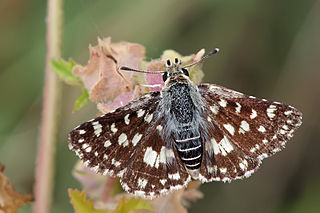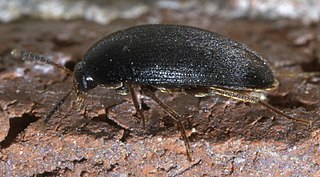
The Rutaceae is a family, commonly known as the rue or citrus family, of flowering plants, usually placed in the order Sapindales.

Apidae is the largest family within the superfamily Apoidea, containing at least 5700 species of bees. The family includes some of the most commonly seen bees, including bumblebees and honey bees, but also includes stingless bees, carpenter bees, orchid bees, cuckoo bees, and a number of other less widely known groups. Many are valuable pollinators in natural habitats and for agricultural crops.

The insects of the beetle family Chrysomelidae are commonly known as leaf beetles, and include over 37,000 species in more than 2,500 genera, making up one of the largest and most commonly encountered of all beetle families. Numerous subfamilies are recognized, but the precise taxonomy and systematics are likely to change with ongoing research.

The Gelechiidae are a family of moths commonly referred to as twirler moths or gelechiid moths. They are the namesake family of the huge and little-studied superfamily Gelechioidea, and the family's taxonomy has been subject to considerable dispute. These are generally very small moths with narrow, fringed wings. The larvae of most species feed internally on various parts of their host plants, sometimes causing galls. Douglas-fir (Pseudotsuga) is a host plant common to many species of the family, particularly of the genus Chionodes, which as a result is more diverse in North America than usual for Gelechioidea.

Bostrichoidea is a superfamily of beetles. It is the type superfamily of the infraorder Bostrichiformia.

Noctuoidea is the superfamily of noctuid or "owlet" moths, and has more than 70,000 described species, the largest number of any Lepidopteran superfamily. Its classification has not yet reached a satisfactory or stable state. Since the end of the 20th century, increasing availability of molecular phylogenetic data for this hugely successful radiation has led to several competing proposals for a taxonomic arrangement that correctly represents the relationships between the major lineages.

Pyrginae, commonly known as spread-winged skippers, are a subfamily of the skipper butterfly family (Hesperiidae). The subfamily was established by Hermann Burmeister in 1878. Their delimitation and internal systematics has changed considerably in recent years with the most recent review being in 2019.

Staphylinoidea is a superfamily of beetles. It is a very large and diverse group with worldwide distribution.

The Apinae are the subfamily that includes the majority of bees in the family Apidae. It includes the familiar "corbiculate" bees—bumblebees, honey bees, orchid bees, stingless bees, Africanized bees, and the extinct genus Euglossopteryx. It also includes all but two of the groups that were previously classified in the family Anthophoridae.

Tetratomidae is a small family of beetles sometimes called polypore fungus beetles. The family consists of several genera, most of which used to be in the family Melandryidae. Tetratomidae can be found worldwide.

Cryptophagidae is a family of beetles with representatives found in all biogeographic realms. Members of this family are commonly called silken fungus beetles and both adults and larvae appear to feed exclusively on fungi although in a wide variety of habitats and situations, such as rotting wood and shed animal fur and feathers. These beetles vary from about 1 to 11 millimeters long, and usually have an oval body shape with a slight "waist".

Philopotamidae is a family of insects in the order Trichoptera, the caddisflies. They are known commonly as the finger-net caddisflies.

The Rhyparochromidae are a large family of true bugs. Many species under Rhyparochromidae are commonly referred to as seed bugs, as are other species within the wider Pentatomomorpha. The family includes two subfamilies, more than 420 genera, and over 2,100 described species.

The Thyatirinae, or false owlet moths, are a subfamily of the moth family Drepanidae with about 200 species described. Until recently, most classifications treated this group as a separate family called Thyatiridae.

Eristalinae are one of the four subfamilies of the fly family Syrphidae, or hoverflies. A well-known species included in this subfamily is the dronefly, Eristalis tenax.

Mataeomera is a genus of moths of the family Erebidae erected by Arthur Gardiner Butler in 1886. It is considered by some sources to be a synonym of Autoba.

Odice is a genus of moths of the family Erebidae. The genus was erected by Jacob Hübner in 1823.
Rhypagla is a monotypic moth genus of the family Erebidae erected by Ian W. B. Nye in 1975. Its only species, Rhypagla lacernaria, was first described by Jacob Hübner in 1813. It is found in northern Africa, southern Europe, Cyprus, Transcaucasia, the Middle East and Iran.

The Erebidae are a family of moths in the superfamily Noctuoidea. The family is among the largest families of moths by species count and contains a wide variety of well-known macromoth groups. The family includes the underwings (Catocala); litter moths (Herminiinae); tiger, lichen, and wasp moths (Arctiinae); tussock moths (Lymantriinae), including the arctic woolly bear moth ; fruit-piercing moths ; micronoctuoid moths (Micronoctuini); snout moths (Hypeninae); and zales, though many of these common names can also refer to moths outside the Erebidae. Some of the erebid moths are called owlets.

Odice suava is a species of moth of the family Erebidae. It was described by Jacob Hübner in 1813. It is found in southern Europe, Algeria, Turkey and the Middle East.



















